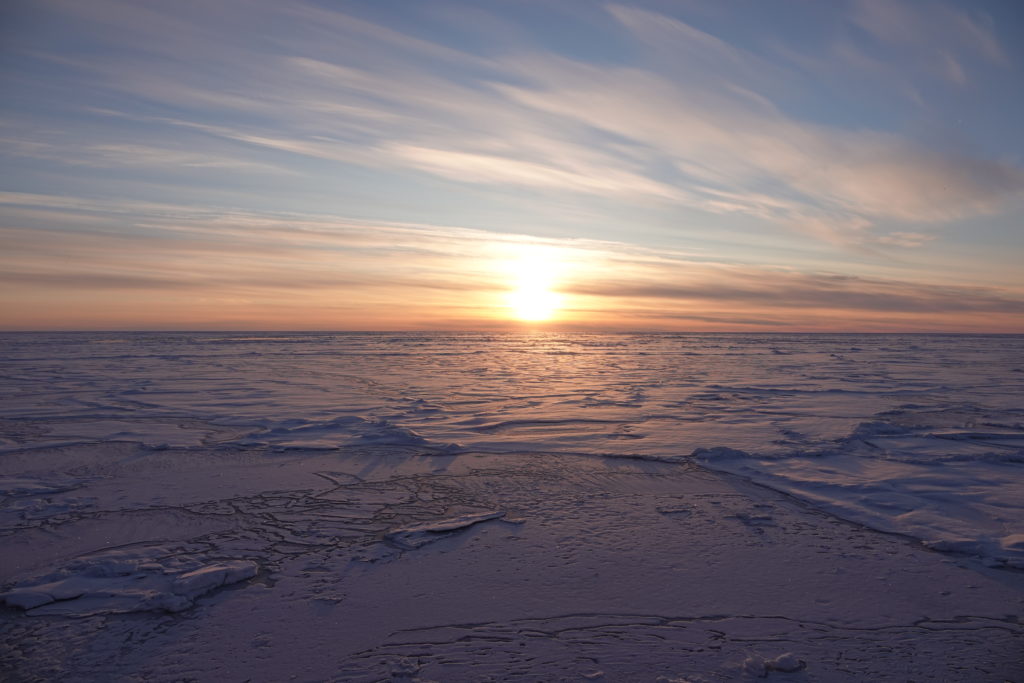
Arctic ice has a variety of textures, and that variety–along with seasonal changes in sun intensity–mean previously proposed geoengineering efforts with hollow glass microspheres could enhance, rather than prevent, ice melt, according to a new paper published in Earth's Future. Credit: Melinda Webster.
A proposal to cover Arctic sea ice with layers of tiny hollow glass spheres about the thickness of one human hair would actually accelerate sea-ice loss and warm the climate rather than creating thick ice and lowering the temperature as proponents claim, according to a new study.
Sea ice, by reflecting the majority of the sun's energy back to space, helps regulate ocean and air temperatures and influences ocean circulation. Its area and thickness are of critical importance to Earth's climate. A 2018 study argued that repeated spreading of hollow glass microspheres on young Arctic sea ice would increase reflectivity, protect it from the sun and allow it to mature into highly reflective, multi-year ice.
The new study rejects that claim, finding instead that placing layers of white hollow glass microspheres onto Arctic sea ice would actually darken its surface, accelerate the loss of sea ice and further warm the climate. The new research was published today in the AGU journal Earth's Future.
According to the 2018 study, five layers of the microspheres would reflect 43% of the incoming sunlight and allow 47% to pass through the spheres layers to the surface below. The remaining 10% would be absorbed by the microspheres - enough to hasten the melting of ice and further warm the Arctic atmosphere, the new research shows.
"Our results show that the proposed effort to halt Arctic sea-ice loss has the opposite effect of what is intended," said Melinda Webster, a polar scientist at the University of Alaska Fairbanks Geophysical Institute and study author. "And that is detrimental to Earth's climate and human society as a whole."
Webster and colleague Stephen G. Warren of the University of Washington calculated changes in solar energy across eight common surface conditions found on Arctic sea ice, each of which have different reflectivities. They also considered seasonal sunlight, the intensity of solar radiation at the surface and at the top of the atmosphere, cloud cover and how the microspheres reacted with sunlight. They based their research on the same type of microspheres used in the 2018 study and on the same number of layers.
The 2018 study did not fully account for the varying surface type reflectivities or variations that would occur depending on the time of year of microspheres application. A layer of microspheres can increase the reflectivity of thin new ice, which is naturally dark, but the effect would be minimal because thin ice mostly occurs in autumn and winter when there is little sunlight. Thin ice soon gets covered by falling and drifting snow, which increases surface reflectivity.
In spring, solar energy increases with the return of the polar day. At that time, most sea ice is covered by deep, reflective snow. Because of snow's high reflectivity, microspheres would darken the snow surface, increasing its solar absorption and subsequently accelerating its melt - the opposite of its intended effect.
The months that would seem most favorable for the application of microspheres - March, April, May and June when sunlight is increasing - are actually the worst months to apply microspheres.
In late spring and early summer, melt ponds begin to form across the sea ice as solar energy increases. Ponds would seem to be an ideal target for the use of hollow glass microspheres because they are dark and have low reflectivity.
But covering ponds with microspheres will not achieve the desired effect. An experiment on a Minnesota pond in the 2018 study showed wind blowing the buoyant spheres to the pond edge, where they clumped, much like pollen does.
Fully non-absorbing microspheres, meaning they absorb 0% rather than 10% of the incoming solar energy, might still not solve the problem because of a simple reason: quantity. About 360 million tons would be needed for a once-annual application to prevent ice melt and cool the climate. And that's assuming the non-absorbing microspheres could be manufactured and dispersed without contamination or other unintended effects.
"The use of microspheres as a way to restore Arctic sea ice isn't feasible," Webster said. "While science should continue to explore ways to mitigate global warming, the best bet is for society to reduce the behaviors that continue to contribute to climate change."






